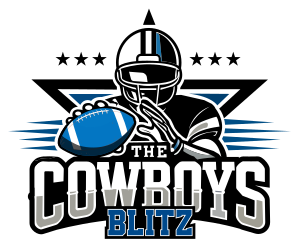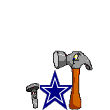Gryphon
Merge Ahead
- Messages
- 3,407
- Reaction score
- 31
Orginally posted by Golden from a sport forum:
My, how things have changed since this time in 2003.
That's when Bill first arrived. That's when he was putting his first Dallas Cowboys team together, inheriting the remnants of three consecutive 5-11 teams, which came on the heels of that 8-8 season in 1999.
Maybe it's just the natural evolution of mankind or training methods or supplements.
But has anyone noticed how much bigger the Cowboys' defensive front has become in a mere three years?
Why first-round draft choice Bobby Carpenter came to town , along with the Cowboys' seven other draft choices, 10 signed rookie free agents and nine more rookies here on workout visas for the three-day mini-camp, and he already weighs more than any of the starting linebackers in 2003.
Entering the premises with him was the 313-pound nose tackle Montavious Stanley. He's all of 24, but weighs just two pounds less than the heaviest guy starting on the 2003 defensive front.
The Cowboys in Bill Parcells' image? Finally?
Make no mistake, Parcells has made a conscious effort to get the Cowboys bigger on defense, and for good reason: You can't play this 3-4 defense with a bunch of munchkins running around out there. Speed is one thing. But when you need linebackers standing up on the line of scrimmage on the edges and when you need defensive linemen big enough to keep the riff-raff off your inside linebackers, you had better go big.
Let's compare what Parcells inherited and what he has been able to assemble in four free-agent off-seasons and four drafts.
When Parcells emerged from his Jersey cocoon back in 2003, here is what became his first starting defensive line: Greg Ellis and Ebenezer Ekuban at defensive end and La'Roi Glover and Willie Blade (his idea) at defensive tackle.
Blade, of course, was the heaviest at 315 pounds. No one else weighed more than Glover, who checked in that year at 285, but probably was closer to 280 by time the season began.
So check this out: The average height and weight of the starting front four was 6-3½, 285½ pounds, and most of that heft comes compliments of Blade, who was 20 pounds heavier than the next heaviest, and a good 50 pounds heavier than the lightest (Ekuban, 265).
Then there were the linebackers, and this is not to say they weren't good players, because Dat Nguyen and Dexter Coakley were fine NFL linebackers in a 4-3 scheme. It's just that neither was 6-foot. Neither was 245 soaking wet.
As for the third guy, and this somewhat surprised me, because I figured Al Singleton was the biggest starting linebacker the Cowboys had back then, but when he arrived here on that four-year free-agent deal from Tampa Bay, fresh off winning a Super Bowl ring, he weighed in at only 228 pounds. I mean, he's 250 now - or so they say. But then, at least he was 6-2, towering over the other two guys by comparison.
So check this out, too: The average height and weight of the starting linebackers back in 2003 was 6-foot, 236 pounds.
Now then, let's compare to today, or at least what we project will eventually become the starting front seven. The three in the 3-4 should be Marcus Spears, Ferguson and Chris Canty, with Greg Ellis, Jay Ratliff, Jason Hatcher, Stanley and possibly Thomas Johnson backing them up. Kenyon Coleman also still is there, but a non-starter heading into his fifth season automatically puts him on the bubble.
Of those guys, Ellis is the lightest at 280. That's a far cry from 2003. I mean, the starters likely will go 294 (Spears), 310 (Feguson) and 295 (Canty). And to think Spears and Canty are just second-year players.
So the current average up front would be 6-5, 300 - nearly two inches taller and 15 pounds heavier than 2003.
Then for the four, or the starting linebackers. At this point looks like that will be DeMarcus Ware, Bradie James, Akin Ayodele and eventually, if all goes well, Carpenter. That would be 255, 250, 246 and 254. And no munchkins. All at least 6-2, with Ware checking in at 6-4.
Add it all up, the projected starting linebackers will average 6-2½, 251 pounds - 2½ inches taller and 15 pounds heavier. And that sure won't change much if Singleton starts off at left outside linebacker since he's now 250.
A serious growth spurt up front.
Not only that, a youth spurt, if you will. OK, Ferguson is the old man of the starting bunch in the front seven. He'll be 32 just after Thanksgiving.
But after that, Ayodele is the next oldest. He's going to turn all of 27 when the Cowboys meet Washington the second game of the season.
And, while we're on this defensive age kick, and since we're not sure of what will happen at free safety, if we look at the other three starters back there, Anthony Henry will be the only other 30-year-old starter, but that won't happen until Nov. 3, two days before the ninth game of the season.
Now the Cowboys might have one more Thirtysomething starter if veteran Marcus Coleman should win the free safety job. He turns 32 May 24. But if he doesn't, that likely means the free safety is either Keith Davis (27) or Justin Beriault (25 in August) or rookie Pat Watkins (23).
All meaning the Cowboys have gotten bigger and younger simultaneously on defense, so you would have to admit, health willing, this is a pretty good defensive foundation that's been laid here in just four off-seasons.
And if compared to 2003, a much more sturdy one, too.
My, how things have changed since this time in 2003.
That's when Bill first arrived. That's when he was putting his first Dallas Cowboys team together, inheriting the remnants of three consecutive 5-11 teams, which came on the heels of that 8-8 season in 1999.
Maybe it's just the natural evolution of mankind or training methods or supplements.
But has anyone noticed how much bigger the Cowboys' defensive front has become in a mere three years?
Why first-round draft choice Bobby Carpenter came to town , along with the Cowboys' seven other draft choices, 10 signed rookie free agents and nine more rookies here on workout visas for the three-day mini-camp, and he already weighs more than any of the starting linebackers in 2003.
Entering the premises with him was the 313-pound nose tackle Montavious Stanley. He's all of 24, but weighs just two pounds less than the heaviest guy starting on the 2003 defensive front.
The Cowboys in Bill Parcells' image? Finally?
Make no mistake, Parcells has made a conscious effort to get the Cowboys bigger on defense, and for good reason: You can't play this 3-4 defense with a bunch of munchkins running around out there. Speed is one thing. But when you need linebackers standing up on the line of scrimmage on the edges and when you need defensive linemen big enough to keep the riff-raff off your inside linebackers, you had better go big.
Let's compare what Parcells inherited and what he has been able to assemble in four free-agent off-seasons and four drafts.
When Parcells emerged from his Jersey cocoon back in 2003, here is what became his first starting defensive line: Greg Ellis and Ebenezer Ekuban at defensive end and La'Roi Glover and Willie Blade (his idea) at defensive tackle.
Blade, of course, was the heaviest at 315 pounds. No one else weighed more than Glover, who checked in that year at 285, but probably was closer to 280 by time the season began.
So check this out: The average height and weight of the starting front four was 6-3½, 285½ pounds, and most of that heft comes compliments of Blade, who was 20 pounds heavier than the next heaviest, and a good 50 pounds heavier than the lightest (Ekuban, 265).
Then there were the linebackers, and this is not to say they weren't good players, because Dat Nguyen and Dexter Coakley were fine NFL linebackers in a 4-3 scheme. It's just that neither was 6-foot. Neither was 245 soaking wet.
As for the third guy, and this somewhat surprised me, because I figured Al Singleton was the biggest starting linebacker the Cowboys had back then, but when he arrived here on that four-year free-agent deal from Tampa Bay, fresh off winning a Super Bowl ring, he weighed in at only 228 pounds. I mean, he's 250 now - or so they say. But then, at least he was 6-2, towering over the other two guys by comparison.
So check this out, too: The average height and weight of the starting linebackers back in 2003 was 6-foot, 236 pounds.
Now then, let's compare to today, or at least what we project will eventually become the starting front seven. The three in the 3-4 should be Marcus Spears, Ferguson and Chris Canty, with Greg Ellis, Jay Ratliff, Jason Hatcher, Stanley and possibly Thomas Johnson backing them up. Kenyon Coleman also still is there, but a non-starter heading into his fifth season automatically puts him on the bubble.
Of those guys, Ellis is the lightest at 280. That's a far cry from 2003. I mean, the starters likely will go 294 (Spears), 310 (Feguson) and 295 (Canty). And to think Spears and Canty are just second-year players.
So the current average up front would be 6-5, 300 - nearly two inches taller and 15 pounds heavier than 2003.
Then for the four, or the starting linebackers. At this point looks like that will be DeMarcus Ware, Bradie James, Akin Ayodele and eventually, if all goes well, Carpenter. That would be 255, 250, 246 and 254. And no munchkins. All at least 6-2, with Ware checking in at 6-4.
Add it all up, the projected starting linebackers will average 6-2½, 251 pounds - 2½ inches taller and 15 pounds heavier. And that sure won't change much if Singleton starts off at left outside linebacker since he's now 250.
A serious growth spurt up front.
Not only that, a youth spurt, if you will. OK, Ferguson is the old man of the starting bunch in the front seven. He'll be 32 just after Thanksgiving.
But after that, Ayodele is the next oldest. He's going to turn all of 27 when the Cowboys meet Washington the second game of the season.
And, while we're on this defensive age kick, and since we're not sure of what will happen at free safety, if we look at the other three starters back there, Anthony Henry will be the only other 30-year-old starter, but that won't happen until Nov. 3, two days before the ninth game of the season.
Now the Cowboys might have one more Thirtysomething starter if veteran Marcus Coleman should win the free safety job. He turns 32 May 24. But if he doesn't, that likely means the free safety is either Keith Davis (27) or Justin Beriault (25 in August) or rookie Pat Watkins (23).
All meaning the Cowboys have gotten bigger and younger simultaneously on defense, so you would have to admit, health willing, this is a pretty good defensive foundation that's been laid here in just four off-seasons.
And if compared to 2003, a much more sturdy one, too.



